Bees are the most valuable pollinators in Florida. Most species here expand beyond the state. A smaller number of bees in Florida are only found here, particularly in its sandy habitats.
In total, it’s estimated Florida has 300 bee species. There are over 4.000 species documented in the US.
The following species are the most common bees in Florida.
Table of Contents
1. Western Honey Bee
The Western Honey Bee (Apis Mellifera) is the most widespread domesticated bee. Beekeepers like this species as it produces honey and beeswax.
The species has a widespread presence on all continents. It lives in colonies under a clear social hierarchy which includes a queen, worker bees, and drones or male bees.

Drones or male bees mate with queen bees in flight. All Western Honey Bee drones die immediately after mating.
The insemination process requires a strong convulsion which is an effort that’s lethal to male Western Honey Bees.
2. Brown-winged Striped Sweat Bee

This bee species (Agapostemon Splendens) is native to Florida. It pollinates a large number of flowers, particularly various types of mint.
Its color makes it stand out compared to all other bees in the state. With a vivid green body, these bees immediately stand out or resemble mint species they pollinate in body color.
These bees are also known for eating plenty of nectar. They are wrongly associated with being interested in human sweat for its minerals.
However, the Brown-winged Striped Sweat Bee only follows sweaty humans around but it prefers to consume pure flower nectar.
3. Common Eastern Bumble Bee

These bees (Bombus Impatiens) are pollinators that live underground. They nest in the ground. Deep tunnels that spread up to 3 feet characterize their nests best.
Bees establish themselves in the ground. There’s no clear pattern of tunnels as each nest looks different. However, the species has clear rules inside the nest.
Smaller bees are always found towards the center of the nest. It’s here that most bees store honey, which serves as a source of food when inside the nest. Pollen and nectar are consumed by the species outside of the nest.
4. Poey’s Furrow Bee

This bee species (Halictus Poeyi) is part of the Halictus family. These bees are found all over the Northern hemisphere.
Poey’s Furrow Bee has a eusocial habitat. It means the bee lives in families in nests. Up to 200 bees can live in one nest.
The nest of the species is underground. These bees dig burrows where they are mostly found in cells or individual small chambers.
5. American Bumble Bee

The American Bumble Bee (Bombus Pensylvanicus) used to be the most common bee species in the South-East. However, its population is declining.
Still, the American Bumble Bee remains popular in Florida. It can be seen in fields with tall grass where it builds shelters or nests above the ground. It sometimes nests underground as well.
These bees face many predators and parasites which reduces their populations. The main risk to the American Bumble Bee is the easy accessibility to its above-the-ground nest. Most predators seek bees in it.
However, these bees are also slowly improving their nest-building skills. They often consider nesting underground in crevices for extra safety.
6. Eastern Carpenter Bee
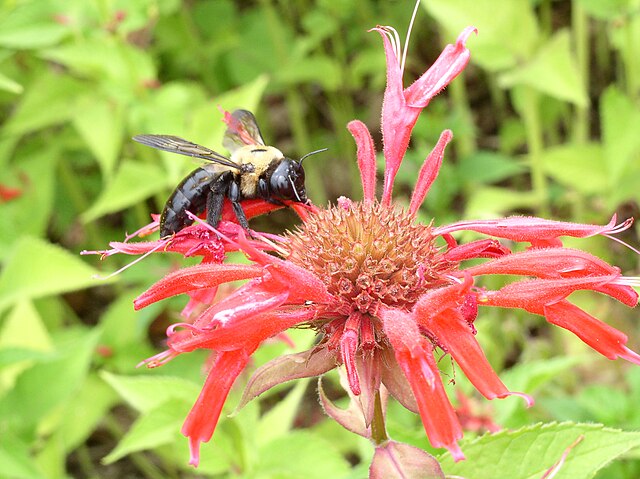
These bees (Xylocopa Virginica) are seen living together. As eusocial bees, the Eastern Carpenter Bee gets its name for its nesting inside pieces of wood.
Species such as the Eastern Carpenter bees like wood, agave, and bamboo where they scrape wood tunneling galleries inside.
They start perpendicular to the grain eventually turning to create chambers along the wood grain. These bees mainly feed on nectar and they also bring nectar back to their nest to offer their young.
7. Southern Carpenter Bee

The black Southern Carpenter Bee (Xylocopa Micans) lives in solitude nesting alone in dead pieces of wood. It faces a reduced habitat in the state, mainly due to excessive urbanization.
These bees construct nests by digging galleries in all types of wood. This includes homes and other structural types of wood which can make them problematic to humans.
Apart from nesting in wood, the Southern Carpenter Bee is also known as one of the rare types of bees with diverse mating strategies.
These bees have been shown to mate in flight. The female releases pheromones to attract males. But females can refuse a certain male mate showing selective reproductive behavior in the species. Males can also refuse to mate with the female, a rare occurrence among Florida bees.
8. Dilemma Orchid Bee

Dilemma Orchid Bees (Euglossa Dilemma) are believed to have arrived in Florida by accident. These bees originate from Costa Rica and Mexico.
The species can be recognized by its green thick body. These are rather small compared to other species, mostly reaching a 0.5-inch body length in maturity.
The bees are known for being one of the few in the state that has large teeth. Male Dilemma Orchid Bees have 3 large visible teeth on their mandibles.
9. Carpenter-mimic Leafcutter Bee

These bees (Megachile Xylocopoides) are recognized by their large bodies and all-black color. Larger than a typical honey bee, the Carpenter-mimic Leafcutter Bee is almost as large as a regular Carpenter bee.
Known for living on their own, these bees are often found on sunflowers and other flowers eating nectar.
As a native species, these bees hare widespread through the state. But their commonality is matched by distinct traits that make them stand out. For example, they are known as the only bees of the species to carry honey under the abdomen.
10. Two-spotted Longhorn Bee

These bees (Melissodes Bimaculatus) are common throughout North America. They are identified by a short black body with yellow hairy legs. The hairs on their legs are used to collect pollen from flowers.
This pollen is carried to feed young bees of the species. Coneflowers and other types of legumes from crops are among their favorites.
It’s believed there are over 100 species of Longhorn bees even if they haven’t been thoroughly studied. The Two-spotted Longhorn bee remains relatively easy to identify given it has yellow hairs on its legs and 2 light spots on its abdomen as its name suggests.
11. Brown-belted Bumblebee

This species (Bombus Griseocollis) is native to the US. It’s found in most states and it’s often recognized due to its yellow second body segment popularly called a ‘belt’.
These bumblebees are similarly sized to other bees in Florida. Most worker bees grow to a length of 0.5 inches. Queen bees are a bit larger growing up to 0.75 inches.
The bees nest underground. Worker bees and queen bees are responsible for keeping up with the nest.
Worker bees use wax to enhance or expand the nest. Their nests are small compared to other species. Brown-belted Bumble Bees live in nests of up to 50 bees.
Male bees inseminate the queen for reproduction. The mating process is complex and even unique compared to other bees. While the insemination process is similar as it’s based on pheromones, it’s the incubation that’s different in these bees.
Male Brown-belted Bumble Bee also incubates pupae. A cocoon is used to pump the abdomen during the process.
12. Blueberry Digger Bee

The Blueberry Digger Bee (Habropoda Laboriosa) is the most important blueberry pollinator. Its activity is considered of higher importance to blueberry pollination even compared to honeybees.
The Blueberry Digger bee is an active species. A single bee can visit up to 50.000 blueberries playing the most important pollination role for these fruits.
The species is known as a digger bee which means it nests in the ground. The underground nest is mainly used to lay eggs in.
The queen bee initially digs a small tunnel in the ground connected to secondary tunnels and individual chambers. Each chamber is then improved with a waxy substance which is believed to have a waterproofing role.
Queen Blueberry Bees then collect blueberry nectar and discard it in individual chambers. An egg is laid on top of the nectar.
The main tunnel of the nest is sealed by the queen until spring. It’s at the first signs of spring that bees emerge out of the nest.
Males emerge first flying around the nest and waiting for females to emerge and mate.
Male Blueberry bees are believed to compete for mating. Some of them dig for the females to shorten the waiting period for mating.
13. Pure Green-Sweat Bee

The Pure Green-Sweat bee (Augochlora Pura) is characterized by a golden-green color which makes it stand out. It’s an important pollinator in the state of Florida.
The species pollinate up to 20 flowers. Pollen and nectar are consumed both by adult and young bees of the species.
A differentiating factor of these bees is their ability to build complex nests in wood. Decaying wood is used as a sheltered nest by these bees.
Mostly located in prairies, these bees only use softwood that’s decaying to build nests with chambers. Each chamber is used to lay an egg that emerges as a bee in the spring.
It’s believed the capacity to lay eggs in secluded places dug in the wood helps protect the eggs. This species has just a few defense mechanisms.
These include the ability to sting (only the females) and the capacity to dig deep nests to keep classic predators such as birds and spiders away.
14. Metallic Epauletted-Sweat Bee
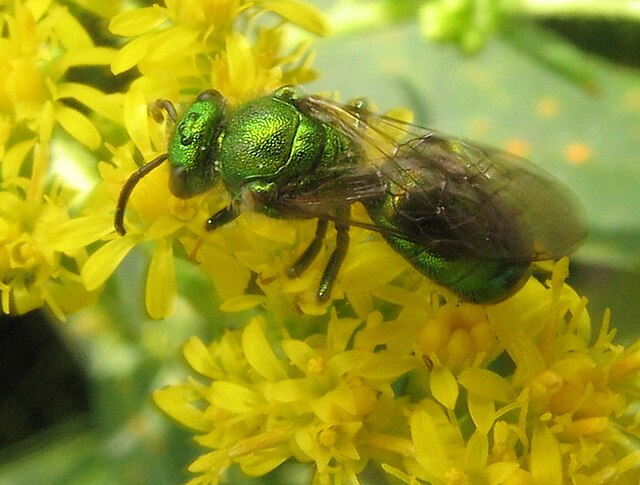
The species (Augochloropsis Metallica) is known for its vivid metallic green color. These bees are rather small. Both males and females grow up to 9mm.
However, they play an important role in the pollination of multiple flowers and other plants. Since they have a large habitat they pollinate a wide range of plants.
Aronia, cornus, verbena, and zizia are some of the common plants these bees pollinate. It’s believed the number of plants it pollinates is growing.
The distribution of the species is responsible for higher plant pollination status. It spreads across Florida and the US as well as through Central America and parts of South America.
15. Flat-tailed Leaf-cutter Bee

These bees (Megachile Mendica) are highly common in the state. They are one of the 16 species of leaf-cutter bees in the country.
Identification is easies by analyzing their black body and flat lower abdomen. These bees are known as common pollinators in the state.
They nest in the ground but rarely dig it. Instead, the bees look for holes and cavities in the ground that are small enough to keep potential predators away but large enough for bees to crawl through and lay eggs in.
The species has been extensively researched. It has been photographed on sunflowers and other small flowers. It was extensively researched with a first mention recorded in 1878.
16. Two-spotted Bumble Bee

These bumblebees (Bombus bimaculatus) are known for their black and yellow body. They are also known for having multiple other species mimicking their looks through camouflage. Robber flys are among the species that impersonate Two-spotted Bumblebees.
Queens emerge in the spring. It’s not unusual to see Two-spotted Bumblebee queens emerge as soon as the end of February. Leaving hibernation, the queen starts to form colonies.
Eggs are laid on pollen and nectar. Queen Two-spotted Bumblebees are known for mating once and then laying eggs. Exceptions have been noted, but only a small percentage of Two-spotted Bumble Bee queens are known to be polyamorous.
These bees are known for foraging Aquilegia flowers. There are 70 types of Aquilegia flowers the species is interested in.
Habits of foraging upside down on these flowers only also attract predators. Crab spiders are the most common predators of the species.
17. Florida Longhorn-Cuckoo
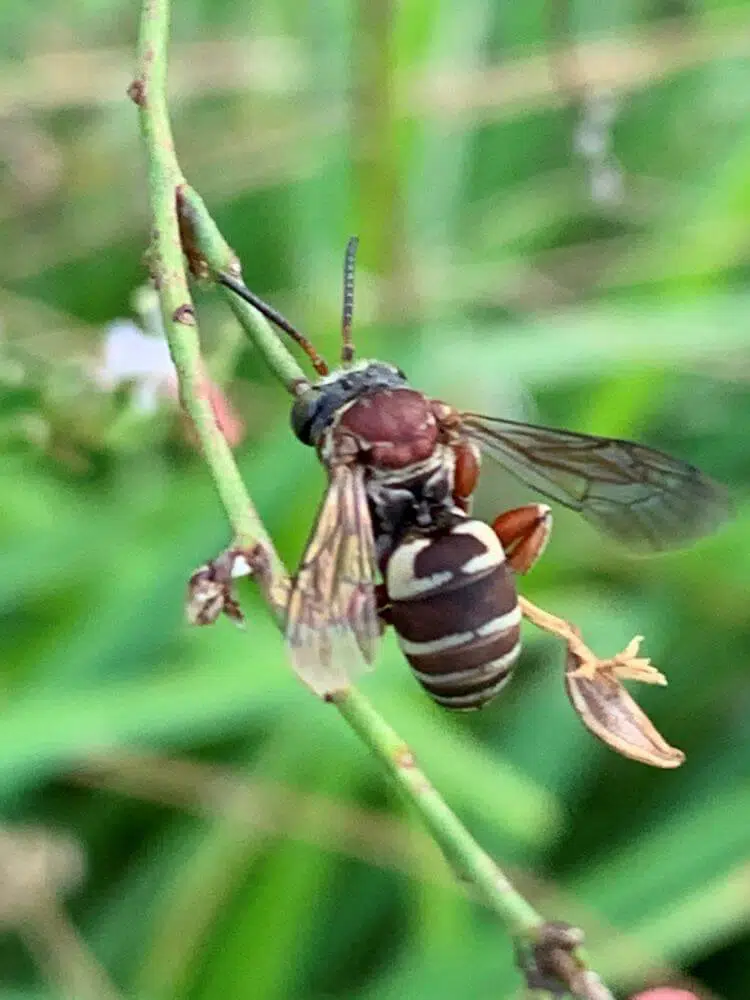
This species (Triepeolus Rufithorax) is a Florida native. It can be recognized by its colored body. The upper part is brown while the head is metallic green. Its lower body is characterized by black and white stripes.
Florida Ceratina
This native species of Florida can be found throughout the state. There are 3 families of bees in this species which include Ceratina cockerelli, Ceratina dupla, and Ceratina floridana.
The differences between the species are small. Sometimes hard to distinguish, these species grow to a maximum body size of 6mm.
These bees mostly resemble Carpenter bees. This is why they also nest in softwood. It’s here that bees bring back pollen. These species are considered some of the best pollinators in the state.
18. Fervid Nomad Bee

These bees (Nomada Fervida) have evolved to a nomadic nature. They are some of the species in Florida that have lost their ability to gather pollen. In rare cases, they can still gather it, but poorly.
The loss of long hairs on their legs is credited with the lost ability to gather pollen. The bees live in burrows.
Female bees fly at low altitudes just above the ground. They look for good burrows to nest in. Sometimes they prefer to lay eggs in the burrows of other species.
The life stages of the species are normal for bees in Florida. Eggs are laid which then turn into larva. The pupa stage follows next before bees turn into adults.
19. Perplexing Rotund-Resin Bee
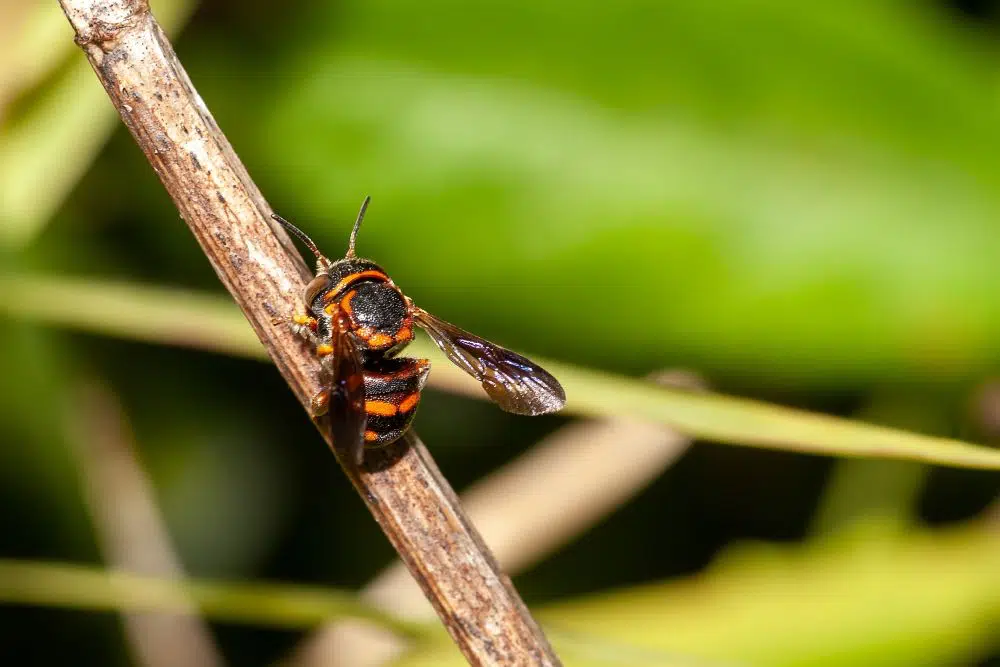
The species (Anthidiellum perplexum) is known for being one of the few in Florida that can only carry pollen on their abdomen. These bees are small, thick, with black and yellow coloration.
Above-ground nesting is specific to these bees. Living solitary lives, they are rarely seen in groups. However, their nests are all types of places that offer some type of shelter, typically just above the ground.
20. Coelioxys slossoni
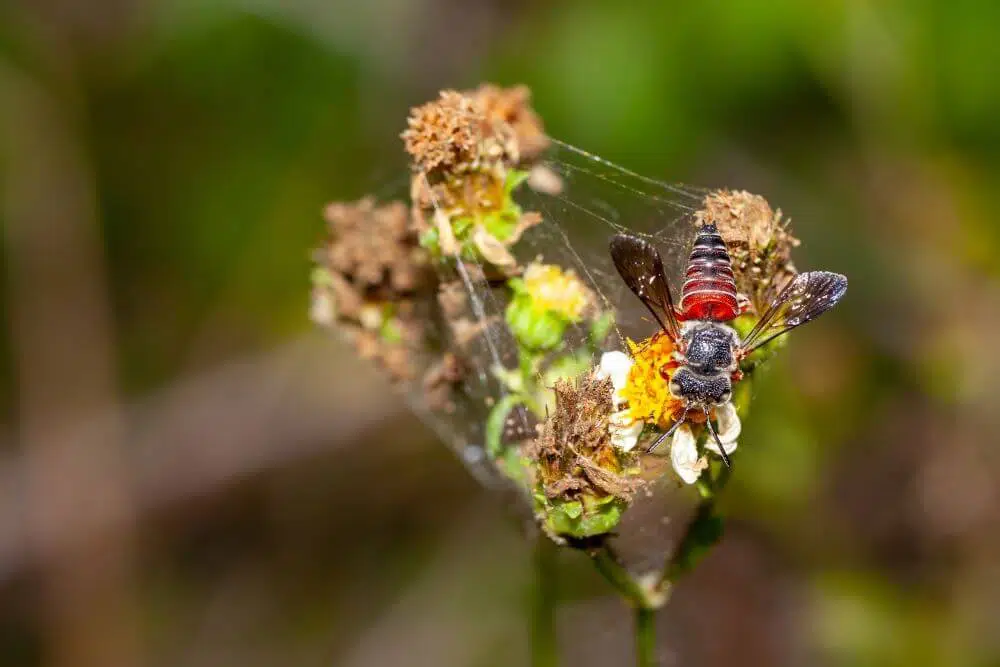
These bees are often overlooked as they emerge late in the season. Mature Coelioxys slossoni bees are only seen in early summer. The species lives short adult lives from June to September.
The bees are identified by their unique body. The head is brown while the rest of the body has black and white horizontal stripes. A thick red stripe runs across the mid-section of these bees.
Both the female and the male have the same size. These are large bees that sometimes reach a size of 12mm.
21. Shining Oil-digger Bee
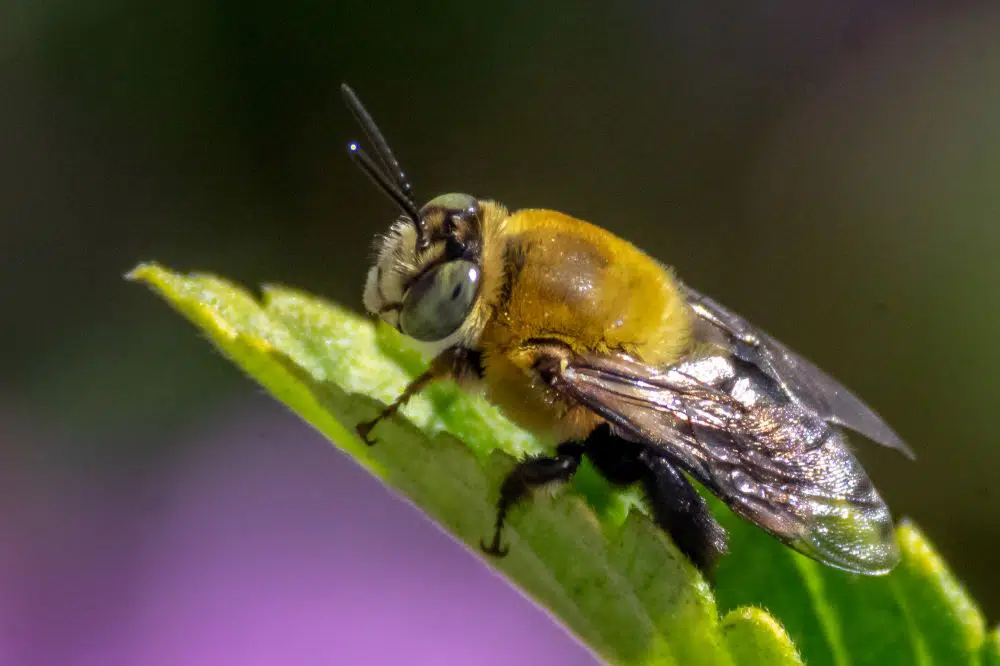
These bees (Centris nitida) get their name from collecting flower oil instead of nectar. Some of the bees also collect nectar but they can collect plant and flower oil.
The bees have a beige and black body with large eyes.
It’s only recently that the bees were spotted in Florida. Mostly living in Central and South America, these bees were rarely seen across the border.
Today, they have a growing presence in South Florida. They are considered invasive bees even if direct damages or conflicts with local species haven’t yet been recorded.
22. Southern Plains Bumble Bee

With reduced numbers across the state, the Southern Plains Bumble Bees (Bombus Fraternus) aren’t as common as they used to be. Only 15% of these species live today.
Native to the US, the bees are also seen in Florida. They represent an opportunistic species mainly living underground.
The bees don’t dig their underground nests. Existing cavities and holes in the ground are used as a nesting place for these black and yellow-banded bees.
These nests have to be at a very specific depth, preferably as close as possible to the surface. Hibernation also takes place in these shallow cavities.
The queen bee is often found hibernating, not deeper than 2 inches below the ground. The queen emerges in the spring.
23. Megachile albitarsis

These bees are most common in Florida. Over time, they made their way to the other Southern States and across the border to Mexico and beyond in Central America.
These bees are often seen eating pollen. Some sub-species are known kleptoparasities. This means they eat pollen collected by other bees.
24. Coelioxys dolichos
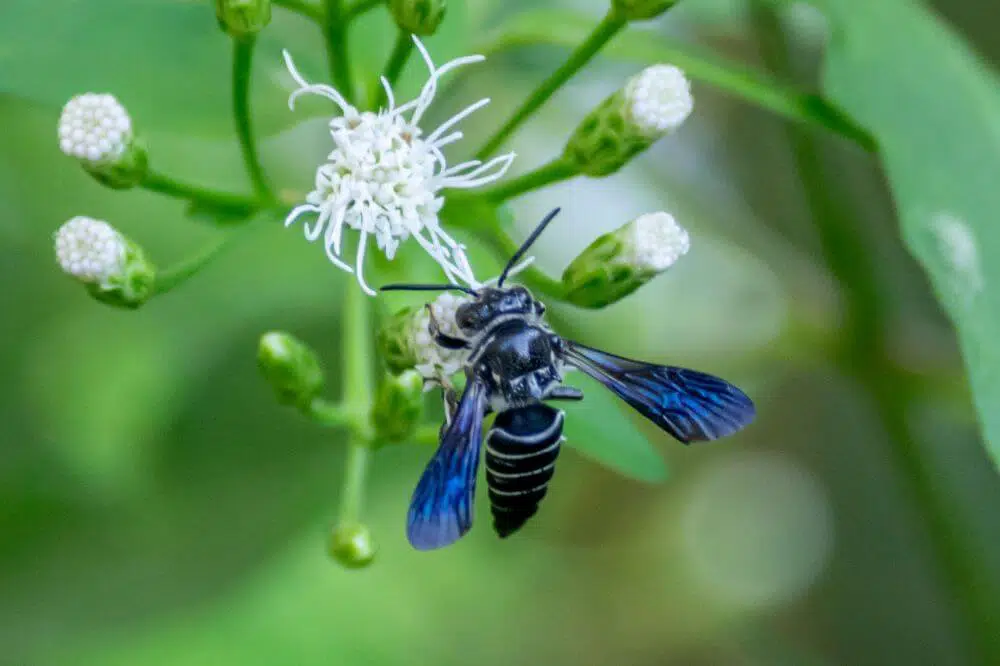
These bees are part of the Acrocoelioxys genus. They have been spotted in populous areas of Florida which means they are accustomed to human presence, but not to the extent of Southern Plains Bumble Bee.
The species is known for nesting in rotting or soft pieces of wet wood. They live solitary lives and they have been characterized as large by Florida standards.
Males are smaller than females, mostly reaching a body size of up to 12mm. Females reach a body size of up to 15mm.
25. Osmia chalybea

These bees have the shortest lifespan of all Florida bees. They are only seen from March until May which is also why they are sometimes estimated to have fewer numbers.
They are recognized by a very distinct dark blue to a black metallic body.
There are considerable differences between females and males of the species. Females grow to a full size of 15mm while males only grow to 11mm.
26. Common Longhorn Bee
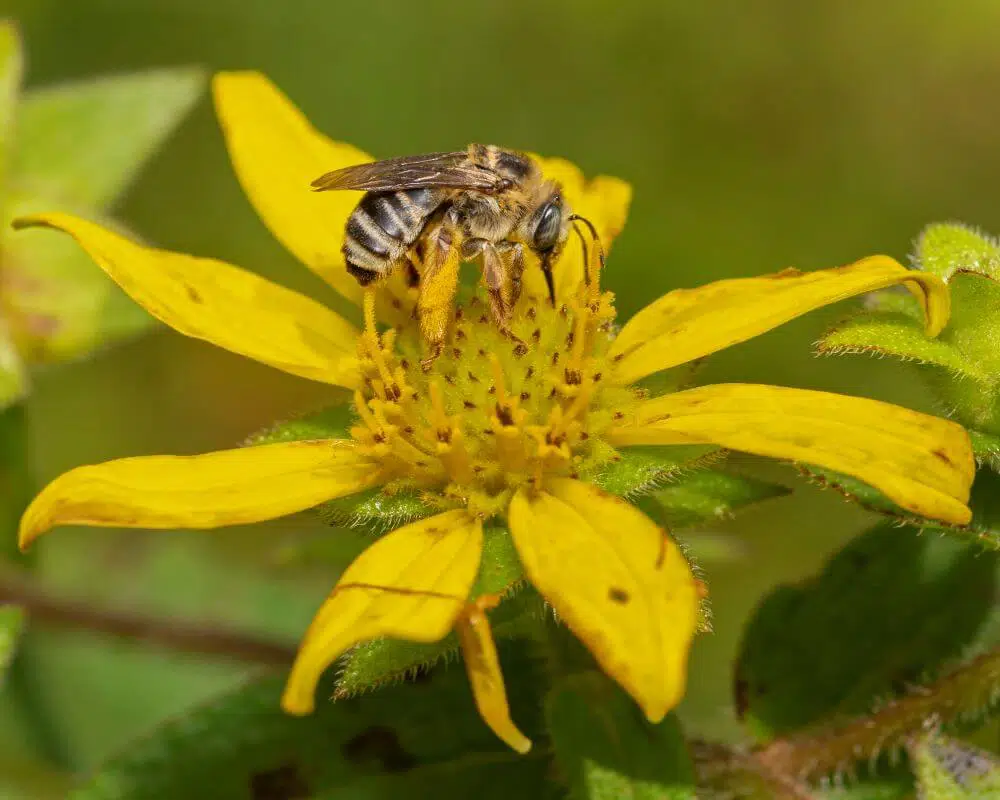
The common Longhorn bee (Melissodes Communis) is the most prevalent in Florida even if it’s widely found across the US and in Southern Canada.
This species is a known pollinator. It has an important role in the pollination of wildflowers. It also has economic importance in North America. It’s a pollinator of squash, blueberry, sunflower, mustard, and other fruiting plants.
Further Reading: